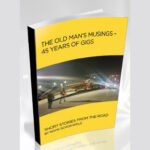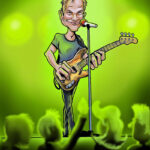Christopher Scoates’ New Book on Radiohead LD Andi Watson
I have always been an avid fan of the lighting, video, and stage designs of Andi Watson, and I’ve been lucky enough to have spoken with him on a few occasions about his work and the cutting-edge new products that he often uses in his designs. To me, he belongs on any list of the groundbreaking concert designers working today, and when I saw that there was a book about his work coming out, I had to get a copy of it.
Watson, best known for his designs for Radiohead — the title is a reference to one of the band’s songs — is also well-known for embracing new technology and risk. Watson was one of the first designers to put video into an LED striplight for a very low-resolution video effect, for example. And rather than simply lighting a band, he creates immersive Light Art installations that serve as performance spaces. But these performance spaces are anything but static. “I am interested in translating the music into a visual form,” notes Watson, who has completely blurred the line between lighting and video.
 Lighting as Art
Lighting as Art
Bullet Proof… I Wish I Was, subtitled The Lighting & Stage Design of Andi Watson, was written by Christopher Scoates. While certainly not your typical lighting book, it is very “typical” of Watson’s work — it’s something much more than you expect. Fittingly published by Chronicle Books, a company known for their fine art books, Scoates’ book also focuses on the art and the influences on Watson’s designs rather than the technology behind it.
The author is the director of the University Art Museum, California State University, Long Beach. His interest ranges from art, technology, music and their relationship with contemporary culture, and that interest has resulted in this beautifully written and illustrated monograph about Watson’s design work. There are also two very thoughtful and fascinating essays by Dick Hebdige and J. Fiona Ragheb.
 Focusing mostly on Watson’s long working collaboration with Radiohead, which spans more than 15 years, the book also touches on Watson’s work with other artists. It’s a well-crafted read, both informative and inspiring. The book is by no means biographical. Instead, it’s more a thesis-like approach to Watson’s artistry, which is a refreshing reminder to those of us who are all too aware of how the “magic” actually happens that design is, at its core, artistic expression, where the result stands on its own while simultaneously serves as a collaboration in the greater performance.
Focusing mostly on Watson’s long working collaboration with Radiohead, which spans more than 15 years, the book also touches on Watson’s work with other artists. It’s a well-crafted read, both informative and inspiring. The book is by no means biographical. Instead, it’s more a thesis-like approach to Watson’s artistry, which is a refreshing reminder to those of us who are all too aware of how the “magic” actually happens that design is, at its core, artistic expression, where the result stands on its own while simultaneously serves as a collaboration in the greater performance.
Many of the book’s 288 pages include photographs and diagrams rather than just plain text. The text, which includes three essays, is rich with information and leads the reader to think more about concept and experience than of technical and practical application of light.
Design Influences
 After a brief foreword by Radiohead’s Thom Yorke, Scoates starts laying the foundation for looking at Watson’s work as art, first and foremost by taking us back for brief highlights of lighting history. This includes a bit on early stage lighting and moves very quickly to the experimental work of Glenn McKay and Mark Boyle in the 1960s, then on to Mike Leonard and Marc Brickman’s work for Pink Floyd, Patrick Woodroffe’s designs for the Rolling Stones and Willie Williams’ many collaborations with U2. (Designer and architect Mark Fisher is also noted for having collaborated with all three of those bands.)
After a brief foreword by Radiohead’s Thom Yorke, Scoates starts laying the foundation for looking at Watson’s work as art, first and foremost by taking us back for brief highlights of lighting history. This includes a bit on early stage lighting and moves very quickly to the experimental work of Glenn McKay and Mark Boyle in the 1960s, then on to Mike Leonard and Marc Brickman’s work for Pink Floyd, Patrick Woodroffe’s designs for the Rolling Stones and Willie Williams’ many collaborations with U2. (Designer and architect Mark Fisher is also noted for having collaborated with all three of those bands.)
Scoates then moves through Watson’s work with Radiohead, looking at the designs of the different tours and the artistic influences that informed both Watson and the bands’ choices. Here he includes comments from both Watson and Yorke that further enlighten the reader on how the visuals worked with the music.
The other two essays in the book both help to put Watson’s work into the context and lexicon of the fine art world. The book’s second text section includes a very interesting essay by Ragheb that compares and contrasts Watson’s designs with different artists and different mediums, including film and different movements. Ragheb also looks at the symbiotic influences of Watson’s work and those art movements.
The third and final essay in the book is by Hebdige, a very good take on the Light Art movement starting in the 1960s covering the “Mad Scientist”-like experimentation with light and projection that would go on to influence concert designs. He writes about several specific installations or events that leaves the reader better informed about the movement and Light Art worldwide. All of this early experimentation had a definite influence on today’s designers. The tools may have changed, but the daring levels of lighting, video, and production design continue to grow and expand.
Beyond Entertainment
As a whole, the book leaves the reader better informed. I knew some of the history of this art form, but learned a great deal more about the origins in the U.K. and Europe as well as some of those in the U.S. who were early pioneers. It also illuminates the place lighting design occupies in the broader art world, beyond entertainment. I also like that comments from Watson about his design process, and how he realizes his ideas, are interspersed throughout the book, along with some great quotes on lighting.
The book also includes wonderful (and long) photo sections depicting the imagery Watson created for different Radiohead tours, along with plots and diagrams of the stage shows. The clarity, color and quantity of the photography is all beautiful. My only quibble is that, since the book measures only 7 by 9 inches in size, and there are two or three photos per page, the photos and plan views are rather small. Also, although the photography is really good, for the most part, the P.O.V. is straight on to the stage. I would have preferred seeing images showing different perspectives. As Watson himself notes in the book, the 3D set for Radiohead’s In Rainbows tour is perhaps better appreciated in an off-axis view.
The book covers Watson’s work form 2000 to 2009, and along with tours for Radiohead, the book includes Watson’s lighting designs for Vanessa Paradis, Dido, Oasis, Zazie, Arctic Monkeys, Counting Crows, and Lenny Kravitz. Each tour is followed with a full list of designers, technicians and supporting suppliers and vendors.
I would say that that Bullet Proof… I Wish I Was really does justice to Watson’s design work, while putting that work in an interesting perspective among other artists working in different media. Although it would benefit from larger photos, and more photos taken from different perspectives, the photography is well done and reproduced nicely.
I always like to read and look at monographs of fine artist’s work. I don’t see why there aren’t more monographs by mainstream publishers documenting the creativity of today’s lighting, scenic and production designers. I applaud Chronicle Books for seeing the value of entertainment design as art. The productions that we work on are all ephemeral and, if not seen live, most likely will not be seen again. It is nice to see a record with the photos put into context of the designer’s artistic eye. I highly recommend Bullet Proof… I Wish I Was. I found the book a fascinating take on Watson’s work, and on lighting designs overall.


